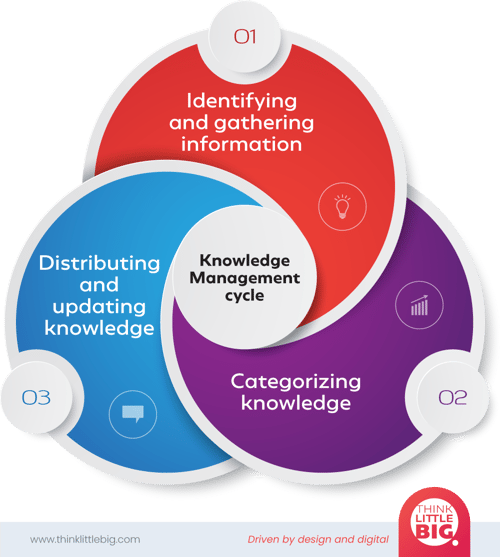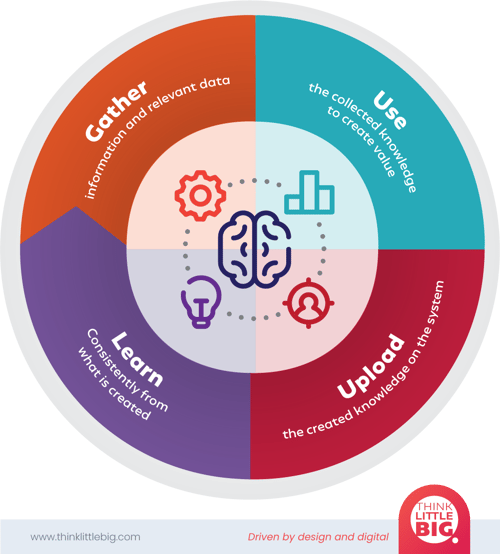May 25, 2021
 by Asavari Sharma / May 25, 2021
by Asavari Sharma / May 25, 2021

Knowledge is a critical competitive differentiator when it comes to driving organizational performance. Regardless of industry niche and business offering, employees across any organization possess knowledge worth sharing.
Although many businesses have increasingly realized how important it is to cultivate a work environment that respects and fosters the accumulation and application of knowledge, only 9% of them are willing to address this trend.
As a business owner, you must understand that at the heart of every successful venture lies a well-formulated plan, which requires deep knowledge, technical proficiency, and effective employee collaboration to implement. That’s where knowledge management comes into play.
Knowledge management refers to a set of tools, processes, and practices that help enhance an organization’s productivity.
Knowledge management (KM) is the process of capturing, storing, sharing, and managing knowledge and information for an organization.
It promotes an integrated approach to identifying and capturing knowledge, storing it in the form of assets like documents or software, and facilitating its easy retrieval and dissemination within the business. Knowledge management systems include FAQs, community forums, training programs, tutorials, and how-to guides.
The quest for consuming information has always been central to human behavior. So it isn’t surprising to know that the concept of ‘knowledge management’ has been around for centuries before gaining prominence in the early/mid-eighties due to business guru Peter Drucker.
Originally, knowledge management meant documenting everything. However, this led to complicated and extensive stores of documents which quickly became outdated and were hard to sift through – frustrating employees to the point where they had to reinvent the wheel each time.
Moreover, knowledge tended to be locked away in team silos with a general resistance to sharing, as it was believed that ‘knowledge was power,’ and to give it away meant losing that power.
It soon became apparent that new approaches were needed to capture and store knowledge for efficient use and to encourage a culture of knowledge sharing, resulting in the concept of knowledge management we know today.
There are three main types of knowledge: explicit, tacit, and implicit. While explicit knowledge consists of documented facts, tacit knowledge is more about innate abilities or on-the-job experience and can be challenging to share.
On the other hand, information that isn’t tangible originally but can be transferred into a tangible form, such as dictation of a speech, is implicit knowledge. Knowledge management captures and disseminates all these types of knowledge. There are three main aspects to it you must understand.
This involves identifying all current and potential knowledge sources in your business. While gathering documents and brochures is just one aspect of it, you must also identify subject matter experts whose knowledge can be captured in the form of shareable content.
This is where all of the knowledge content is stored in an easy-to-use retrieval system under suitable categories. For example, in the case of tacit knowledge, the experts in your team can write what they know in the form of case studies, blog posts, or even videos or infographics.
This involves disseminating the knowledge to anyone who needs it and encouraging your employees to use the system regularly. Appointing knowledge management champions and incentivizing learning can help with this.

Most organizations typically follow a four-step process to catalog their knowledge content into an accessible system. Here is what you can take away from them:
This is the first step, where the sources of knowledge are identified and where critical knowledge is currently stored. It requires meticulous attention to detail and a keen understanding of your business, usually conducted by subject matter experts.
You should identify any redundant or incorrect knowledge sources at this stage and decide whether to update them for accuracy or to scrap them as unnecessary.
At this stage, you should chalk out a consistent, comprehensive, and easy-to-use system by which all the collected knowledge is stored and categorized. This step can include scanning documents and using metadata and indexing to ensure that knowledge is appropriately stacked and accessed.
This is where you establish and promote a cultural shift toward knowledge. Finally, all the knowledge gathered and sorted in the previous two steps needs to be disseminated within the organization so that your employees can use it in their daily tasks.
You can appoint ‘knowledge leaders’ who will champion the use of the knowledge management system among their teammates or even develop an internal marketing program to get people excited about the new system.
The most comprehensive knowledge management system in the world can come to naught if employees do not know how to use it. At this step, therefore, you can develop training programs that demonstrate how to use the system. There should also be a provision for your employees to ask for help or make suggestions, as needed.
A Deloitte survey states that 80% of professionals agree that sharing knowledge helps them gain a competitive advantage and add real client value by considerably bringing down customer support costs. In fact, 74% of organizations believe that effective investment in knowledge management boosts business productivity by 10–40%.
So while effective knowledge management improves employee productivity and reduces operational costs, it also offers eight key benefits.
Knowledge management promotes the centralization of all knowledge content in real-time on a user-friendly system that anyone can access. That means your employees can quickly get the information they need rather than having to ask around about who might have the document in question.
While the paucity of information hinders employees in many ways, and information overload has its problems, a knowledge management system can send personalized RSS feeds to each employee based on their search history and interest areas, giving them valuable inputs without overwhelming them.
Every employee brings a unique set of skills and experiences to the table, many of which can prove invaluable in problem solving and stratification. However, particularly in medium to large organizations, employees often do not know anyone outside their immediate teams.
With a knowledge management system, collaboration becomes easier as your employees can drop a line to relevant stakeholders from any team having the relevant skills and expertise.
Similarly, subject matter experts can be invited to share blog posts or white papers on their topics of expertise or to participate in community discussions or open houses where your employees across the organization ask them questions.
Did you know 44% of employees handle knowledge transfer rather poorly? By having easy access to your organization’s repertory of knowledge, decision-making becomes much easier for your employees.
They can pull up case studies or tutorials as and when they need to or use enterprise collaboration tools to quickly connect with teams whose experiences and perspectives could enrich the decisions.
With the help of a knowledge management system, your employees can look up answers to questions that they have and improve their funds of knowledge by studying the content uploaded on the system.
The more an employee becomes knowledgeable about a particular process or product, the greater their chances of contributing to projects related to that area. Knowledge management, allows for the professional development of employees without you having to spend anything extra.
When knowledge access and sharing becomes easier, your customer service team, for instance, can answer customer questions faster and more accurately and also reach out to team members in other departments for clarification.
Speed is a significant differentiator from the competition, as is the accuracy of the response. Better customer resolution means more satisfied customers, which means more wins for your business in the long run.
Don’t be surprised when we tell you employees spend 30% of their time, on average, looking for or recreating information that already exists.
Through streamlined processes and consistent knowledge standards, your employees can avoid repeatedly looking up the same things and wasting time. In addition, the reduction of redundant effort improves employee motivation and speeds up operations throughout your organization.
According to Darroch, organizations with well-developed knowledge management practices are more likely to innovate successfully. That’s because knowledge management promotes effective collaboration and knowledge sharing, which can stimulate innovation and brainstorming.

That enables product launches, process upgrades, technological advancements, and other new ventures that can help your organization stay ahead of the curve.
Knowledge is an asset but managing something intangible or immeasurable requires you to get your basics right. Unfortunately, despite the positives of knowledge management, the majority of businesses are unable to glean most of the concept. Interestingly, a huge reason is the issues that lie with their organizational culture, i.e. how knowledge management is promoted among employees.
In a survey published in Critical Knowledge Transfer, 53% of C-suite respondents said the losses incurred due to poor knowledge transfer among employees fell somewhere between $50–$299K per employee. To avoid finding yourself in a similar situation, you must implement proper knowledge management techniques in your business:
The effectiveness of a knowledge management system depends on how people use it, rather than how expensive or elaborate the system is.
It is thus essential for you to understand the current workplace culture and what behaviors your employees display. For instance, if the team is used to learning from visual content, implementing a text-heavy knowledge management system may not yield optimal results.
Human beings often tend to view any significant new changes with suspicion, and abruptly implemented changes will lead to them shying away.
Instead, have a step-by-step plan in place to introduce the knowledge management system to your team and let them get used to it. This also provides valuable insights on user adoption at each stage and any glitches that need to be fixed.
In addition to formal knowledge content like instruction guides or case studies, informal knowledge like debrief or review sessions after essential meetings can also help your employees retain new information better. Even a quick session to summarize the vital points, identify areas of improvement and define the way forward can be beneficial.
An excellent way to encourage your employees to use the knowledge management system is by incentivizing them to do it. For example, offer rewards to those who complete a certain amount of reading or training each month and openly appreciate people who are consistent about logging in. You can also have monthly contests or interdepartmental competitions to spur employees on.
Much of the knowledge management database content will come from your subject matter experts and employees who wrote up case studies of their experiences.
Please encourage them to continue sharing insights by giving them ownership of the knowledge they have shared. When employees are credited by name, they feel more appreciated and are likely to contribute again. Knowledge ownership also helps employees know whom to reach out to if they need clarifications on a piece of content.
The implementation of knowledge management will cause a significant change in the organization. Therefore, your employees need to have someone they can reach out to for help with the new system whenever.
Choose someone who has been with the organization for a while, understands the ins and outs of the company culture, and has a certain degree of influence on business decision-making. That way, when your employees approach the executive for help, they know their concerns will be taken into account by senior management.
If your employees have to trawl through lengthy documents each time they log into the knowledge management system, they are unlikely to want to use it very often.
Instead, convert your knowledge into a reader-friendly format by breaking it into short guides, infographics, video tutorials, and FAQ sheets. It also helps to follow a standardized format for all content so that your employees can quickly identify what they need.
Knowledge should be easy to share across channels for all your employees without asking an IT person for help. This incentivizes your employees to use the knowledge management system and frees up the IT team from handling hundreds of service queries.
For instance, a customized RSS feed can deliver relevant content to employees each day based on their interests. In addition, knowledge management champions the sharing of skills and experiences by all – even if it entails defying the existing culture – so that everyone can support, nurture and learn from each other.
As mentioned previously, many organizations are affected adversely when an employee leaves. Therefore, to capture the knowledge and experience that the employee has gained over their tenure, you must have a knowledge exchange policy where their knowledge is transferred to the rest of the team through a briefing session or a case write-up.
For knowledge management to work optimally in your organization, there need to be certain reliable solutions to facilitate knowledge storing and retrieval, streamline dissemination, speed up routine tasks and ensure consistency in knowledge content.
A knowledge management system applies certain principles to help employees find the information they need quickly and efficiently. Here are 11 examples of effective knowledge management software that you could use for your business.
This is the absolute basis of ineffective knowledge management. Knowledge base software is one example of an excellent knowledge management tool. It allows companies to easily store and share knowledge among employees. Every organization should have a central repository of all the technical content, how-to guides, and product manuals that the organization has created.
It should include categories to sort out different types of content and a searchable index, like a digital filing system. Moreover, this content should be revisited at regular intervals and refreshed as needed to stay relevant.
The document management system will typically fall under a broader content management system, including audio, video, and image files besides documents. Given that much valuable information may be shared in the form of tutorial videos, presentations, or talks by senior management, it is essential to collate and categorize this content for easy reference as needed.
A CRM gives you insights into the behavior of your customers at different stages of the buying journey. You can understand how the customer found you, which channel they used to first reach out to you, which pages on your website they explored, which products they wish-listed, what their purchase patterns are, and so on.
You can also reach out to the sales team to understand what communications they have shared with the customer at every stage. This gives you comprehensive insights into customer behavior, from which you can craft best practices, case studies, and FAQ guides that employees can refer to for customer interactions.
Social networking is an informal yet powerful way for employees to connect, have discussions, share information and create interest-based groups. The conversations employees have on social networking platforms can lead to valuable insights and new ideas being generated.
Your organization should encourage such conversations and empower employees to document those insights and ideas in the knowledge management system.
Organizations everywhere are moving away from traditional in-person training and towards virtual learning management systems. Apart from training modules, you can use the learning management system to share additional resources to help employees do their job better.
Data on learning patterns as collected from the system dashboard can also give HR insights into how employees learn and how to improve the training experience.
As knowledge management takes shape and grows in the organization, competency management – examining the organization’s beliefs, values and practice – can be conducted. Once clarity is reached, HR can better understand the competencies that employees need to inculcate to uphold these core beliefs and practices.
Databases are applications that allow people to capture, store, retrieve, analyze and interact with data. They index all data stored to make it more searchable. Databases tend to be highly secure and ideal for business-critical information, patent-related knowledge, or trade secrets.
Organizations may offer employees the opportunity to shadow mentors, senior managers, or subject matter experts. This will give your employees an up-close-and-personal view of the real-life applications of different kinds of knowledge and thus enable them to make a more informed decision about their own upskilling.
Chatbots use machine learning and natural language processing to offer quick answers to your employees (and even your end customers) who have specific questions. Chatbots can facilitate utilizing a knowledge management system by researching on the employee’s behalf.
Often, employees who conduct fieldwork on behalf of the organization gather valuable research data. This should be collated and stored in the knowledge management system for easy reference and avoid duplicity of fieldwork efforts.
Project documents that multiple people and teams have been contributing to in real-time are essential sources of knowledge. Besides, the final documents and relevant comments and suggestions can be stored for reference as an example of collaborative effort and demonstrate what kinds of features are most desirable in projects of that nature.
These are web pages that anyone can create and update to store the business information in a central location. They facilitate collaboration at any time and can be instantly updated when new information comes in. However, given that anyone can access them, the knowledge shared may not always be wholly accurate. It is thus vital to have a content moderator check-in on Wikis from time to time.
Knowledge is indeed power. There’s no stopping your business from gaining a competitive edge if you can identify and structure important information sources in one place besides promoting a culture of knowledge sharing in the workplace.
You might not necessarily execute a proper knowledge management strategy successfully in the first go. In such a case, seek assistance from an expert. Take your time and plan for it properly. Efficient knowledge management doesn’t happen overnight.
Keep improving your processes. Conduct surveys to understand how your employees have or haven’t embraced knowledge sharing, and fill those adoption gaps swiftly. Build your knowledge base proactively for long-term results.
Asavari Sharma is a B2B copywriter who helps small- and medium-sized companies make the most out of their business strategies through engaging content. She is currently the Head of Content at Think Little Big Marketing.
Imagine you are the CEO of a company, delivering cloud data management and data security...
 by Meenakshi Arora
by Meenakshi Arora
Today, every person generates around 1.7 megabytes of data per second.
 by Saravana Kumar
by Saravana Kumar
They say knowledge is power.
 by Deirdre O'Donoghue
by Deirdre O'Donoghue
Imagine you are the CEO of a company, delivering cloud data management and data security...
 by Meenakshi Arora
by Meenakshi Arora
Today, every person generates around 1.7 megabytes of data per second.
 by Saravana Kumar
by Saravana Kumar


